Tower Semiconductor Bundle
How Does Tower Semiconductor Thrive in the Semiconductor World?
Tower Semiconductor, a prominent player in the Tower Semiconductor SWOT Analysis, specializes in analog semiconductors, serving as a crucial specialty foundry for the global tech industry. The company's ability to provide customized process technologies and design services empowers businesses to create cutting-edge products across sectors like automotive and consumer electronics. With impressive financial results, including a 10% year-over-year revenue increase in Q4 2024, the company is clearly making waves.
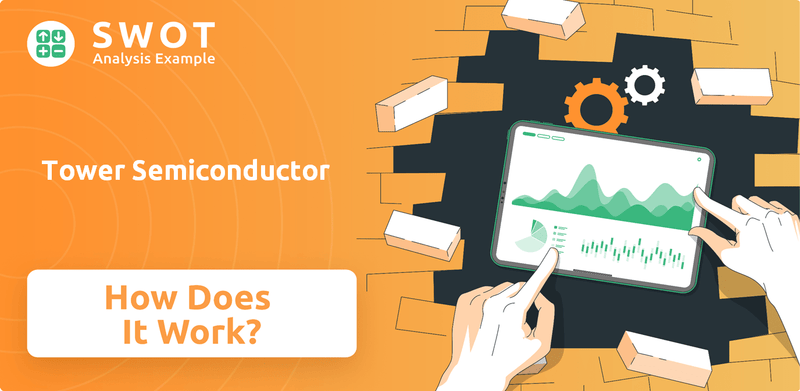
This in-depth exploration will uncover the intricacies of Tower Semiconductor's business model, which focuses on specialized foundry services rather than mass-produced chips. We'll examine its core operations, revenue streams, and strategic initiatives, offering a comprehensive understanding of its competitive landscape and future prospects. Learn about the company's Tower Semiconductor SWOT Analysis, including its financial performance, and how it leverages its Tower Semiconductor technology to stay ahead in the dynamic world of semiconductor manufacturing.
What Are the Key Operations Driving Tower Semiconductor’s Success?
Tower Semiconductor operates as a pure-play specialty foundry, specializing in the manufacturing of integrated circuits (ICs) and semiconductors based on customer design specifications. This approach allows the company to offer highly customizable process technologies and design services, which are crucial for fabless companies and integrated device manufacturers (IDMs) seeking to develop differentiated products. Their focus on specialized analog IC manufacturing sets them apart in the semiconductor industry.
The core value proposition of Tower Semiconductor lies in its ability to provide advanced process technologies. These technologies, primarily based on CMOS platforms with added features, enable unique functionality, reduced product footprints, and competitive performance and cost advantages for analog and mixed-signal semiconductors. Due to the analog characteristics being dependent on Tower's specific process technology, designs are not easily transferable to other foundries, fostering strong customer relationships and creating a competitive advantage. Tower Semiconductor's business model is centered on these specialized manufacturing capabilities.
Tower Semiconductor serves a diverse range of customer segments across high-growth markets, including automotive, industrial, consumer electronics, communications, medical, 5G, and AI. In 2024, the automotive sector accounted for approximately 30% of their revenue, highlighting the importance of this market. Their operational processes encompass manufacturing, technology development, and design enablement, supported by a global network of fabrication facilities.
Tower Semiconductor operates multiple fabrication facilities globally to provide multi-fab sourcing and extended capacity. These facilities include locations in Israel, the U.S., and Japan, as well as access to a 300mm capacity corridor in Intel's New Mexico factory. This global presence ensures flexibility and scalability for their customers.
The company provides world-class design enablement tools for a quick and accurate design cycle. They also offer process transfer services, including development, transfer, and optimization, to IDMs and fabless companies. This comprehensive support helps customers bring their products to market efficiently.
Tower Semiconductor specializes in analog IC manufacturing, offering customizable process platforms. These include SiGe, BiCMOS, mixed-signal/CMOS, RF CMOS, CMOS image sensor, non-imaging sensors, displays, integrated power management (BCD and 700V), photonics, and MEMS. This specialization enables them to cater to complex, high-performance applications.
Their core capabilities translate into customer benefits by enabling the creation of innovative products with competitive advantages. This is particularly evident in areas like advanced power management and radio frequency silicon on insulator (RF SOI) solutions. The company's focus on Competitors Landscape of Tower Semiconductor demonstrates its commitment to maintaining a competitive edge.
Tower Semiconductor's unique position in the market is defined by its specialization in analog IC manufacturing and its customizable process platforms. These factors allow them to serve high-growth markets with complex needs.
- Focus on specialized analog IC manufacturing.
- Customizable process platforms.
- Global manufacturing footprint.
- Strong customer relationships due to technology specificity.
Tower Semiconductor SWOT Analysis
- Complete SWOT Breakdown
- Fully Customizable
- Editable in Excel & Word
- Professional Formatting
- Investor-Ready Format
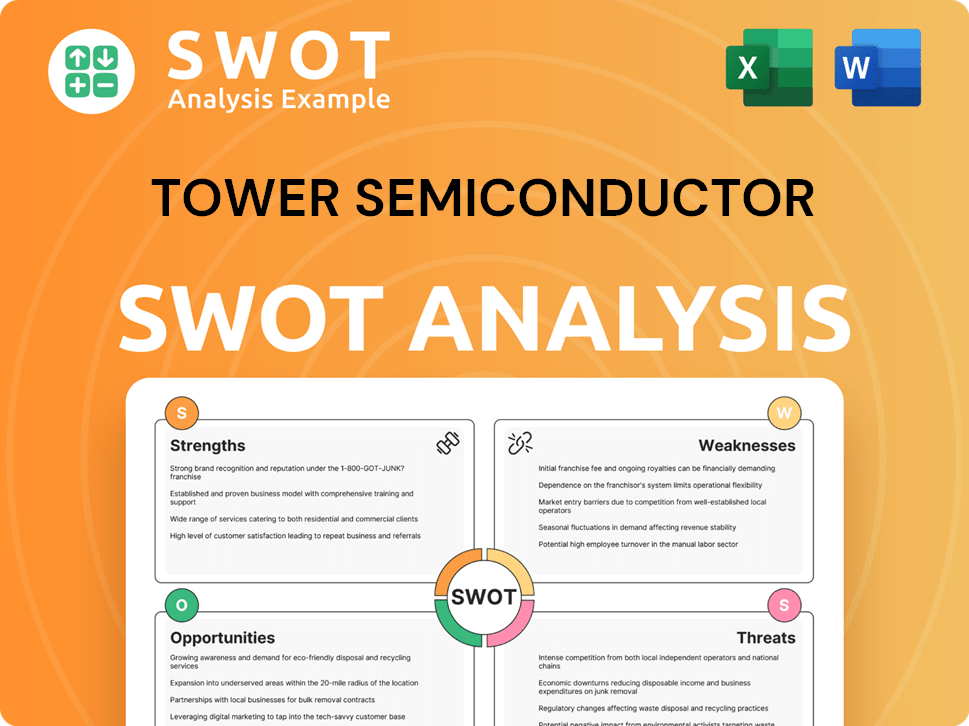
How Does Tower Semiconductor Make Money?
The primary revenue stream for Tower Semiconductor comes from manufacturing integrated circuits and semiconductors based on customer specifications. This specialty foundry model allows the company to focus on analog and mixed-signal semiconductors, catering to diverse markets. The company's financial performance reflects its success in this area.
For the full year 2024, Tower Semiconductor's total revenue was $1.44 billion. The company's revenue streams are diversified across various end markets, which provides stability and reduces dependency on single sectors. In the first quarter of 2025, revenues reached $358 million, a 9% year-over-year increase compared to $327 million in Q1 2024.
The company projects second-quarter 2025 revenues to be approximately $372 million. This indicates continued sequential quarterly revenue growth expected throughout 2025, with acceleration in the second half of the year. This growth underscores the effectiveness of Tower Semiconductor's business strategies and market positioning.
Tower Semiconductor's revenue is diversified across various end markets, reducing reliance on single sectors and enhancing financial stability. This strategy is supported by strategic partnerships and investment in advanced technologies.
- In 2024, the automotive sector accounted for 30% of Tower's revenue.
- In Q1 2025, RF (radio frequency) infrastructure revenue increased from 14% of total revenue in Q1 2024 to 22% in Q1 2025.
- Power management revenue rose from 10% of total sales in Q1 2024 to 18% in Q1 2025.
- The Silicon Photonics (SiPho) business is a notable growth driver, with its revenue more than tripling to $105 million in 2024. It is on track to double its revenue in 2025.
Tower Semiconductor PESTLE Analysis
- Covers All 6 PESTLE Categories
- No Research Needed – Save Hours of Work
- Built by Experts, Trusted by Consultants
- Instant Download, Ready to Use
- 100% Editable, Fully Customizable
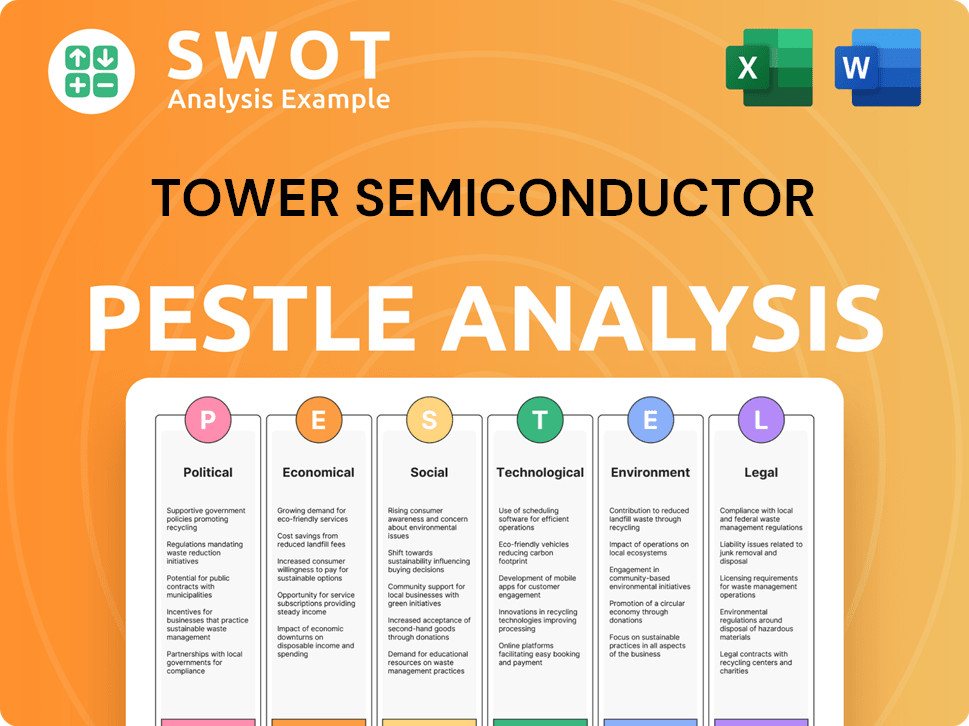
Which Strategic Decisions Have Shaped Tower Semiconductor’s Business Model?
The journey of Tower Semiconductor, a key player in the semiconductor manufacturing sector, is marked by significant milestones and strategic maneuvers. The company has consistently adapted to the dynamic demands of the industry, focusing on specialized analog semiconductors and process technologies. This strategic focus has enabled Tower Semiconductor to carve out a unique position in the competitive landscape, offering tailored solutions that set it apart from larger foundries.
Tower Semiconductor's strategic moves have been pivotal in shaping its operational capabilities and financial performance. A core strategy involves the expansion of its manufacturing capacity, particularly in 200mm and 300mm facilities. These expansions are crucial for meeting the growing customer demand, especially in advanced analog processing. The company's commitment to innovation and technological advancement, including silicon photonics and silicon germanium, further strengthens its competitive edge.
The competitive edge of Tower Semiconductor stems from its expertise in specialty foundry services. This allows the company to provide highly customized solutions, catering to specific customer needs. Partnerships and a diversified market portfolio contribute to its stability and growth. Understanding the Marketing Strategy of Tower Semiconductor provides insights into its approach.
Tower Semiconductor has achieved several key milestones, including expansions to its manufacturing facilities. The company has strategically invested in increasing 200mm and 300mm capacity to meet growing customer demand. These expansions are critical for supporting advanced analog processing and specialized manufacturing services.
Strategic moves include the expansion of manufacturing capacity and technological advancements. Tower Semiconductor has invested in its facilities in San Antonio, Texas, Migdal Haemek, Israel, and Uozu, Japan. The company is also focusing on advanced technologies like silicon photonics and silicon germanium, which are crucial for high-speed data transfers.
Tower Semiconductor's competitive advantage lies in its specialized analog IC manufacturing expertise and its highly customizable process platforms. This allows Tower to tailor solutions to specific customer requirements, differentiating it from larger foundries. Strategic partnerships and a diversified market portfolio also enhance its competitive position.
The company faces challenges such as cyclical demand and intense competition. The semiconductor industry is volatile, impacting financial results and utilization rates. Continuous innovation is crucial to maintain a technological edge. Tower Semiconductor responds by investing in R&D and fixed assets.
Tower Semiconductor's strategic focus on advanced technologies and capacity expansion is evident in its financial performance. The SiPho business more than tripled in revenue in 2024 to $105 million and is on track to double in 2025. The company is also leveraging its global scale and technology breadth to pursue new opportunities.
- 200mm capacity expansion in San Antonio, Texas, and Migdal Haemek, Israel.
- 300mm facility improvements in Uozu, Japan.
- SiPho revenue of $105 million in 2024.
- Approximately 80% market share in silicon photonics for transceivers.
Tower Semiconductor Business Model Canvas
- Complete 9-Block Business Model Canvas
- Effortlessly Communicate Your Business Strategy
- Investor-Ready BMC Format
- 100% Editable and Customizable
- Clear and Structured Layout
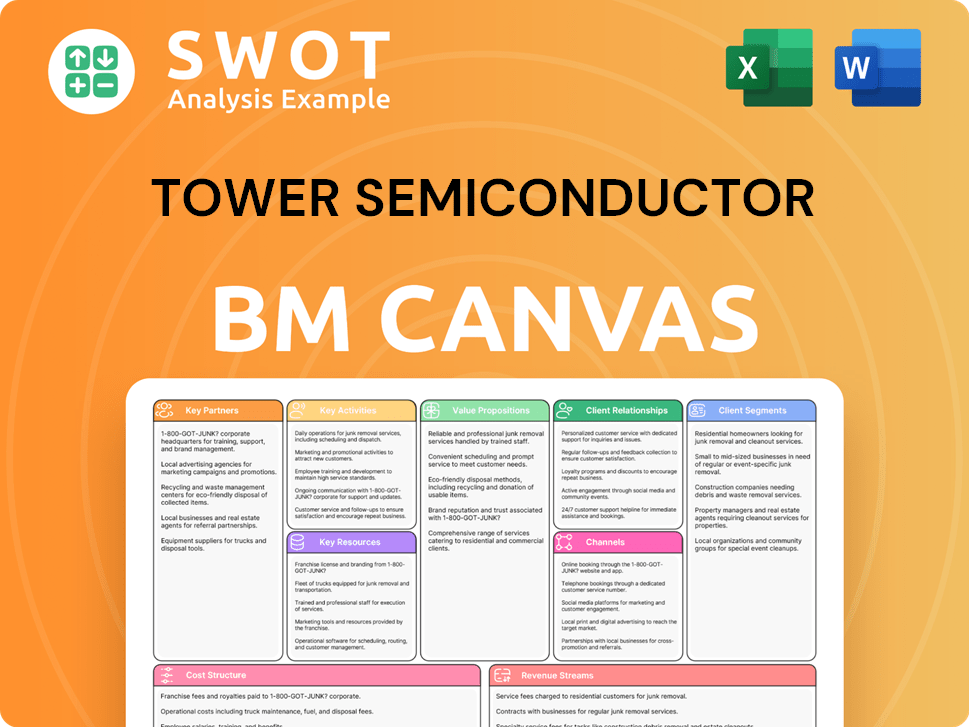
How Is Tower Semiconductor Positioning Itself for Continued Success?
In the realm of semiconductor manufacturing, Tower Semiconductor Company holds a strategic position, particularly in the specialty foundry sector. This focus on analog-intensive, mixed-signal integrated circuits sets it apart from larger players. The company's ability to offer highly customizable process technologies for diverse applications strengthens its market standing. Owners & Shareholders of Tower Semiconductor should be aware of the company's specific market niche and its competitive advantages.
However, the semiconductor industry is inherently cyclical, which means that Tower Semiconductor faces several risks. The volatile nature of the market, along with intense competition, can impact revenues. The company's reliance on continuous capital expenditures and geopolitical risks, such as those in Israel, add to the challenges. Furthermore, a concentrated customer base presents a risk.
Tower Semiconductor specializes in analog semiconductors and mixed-signal integrated circuits, serving diverse markets. The company's focus on specialty foundry services allows it to provide highly customizable process technologies. This strategy has enabled it to maintain a strong position within its niche, despite competition from larger players in the semiconductor manufacturing industry.
The semiconductor industry's cyclical nature poses a significant risk to Tower Semiconductor. Intense competition from larger foundries and IDMs also affects its operations. The company's need for continuous capital expenditures, which were $432 million for the full year 2024 and $111 million in Q1 2025, puts pressure on profitability. Geopolitical issues and a concentrated customer base further contribute to the risks.
Tower Semiconductor anticipates sequential revenue growth throughout 2025, especially in the second half, driven by increased production. The company plans significant capital expenditures, including investments in its New Mexico and Italy fabs. Expansion into new markets and continued growth in key sectors like RF infrastructure are also planned.
Tower Semiconductor aims to achieve $2.7 billion in annual revenue, $560 million in operating profit, and $500 million in net profit at full fab loading. These targets reflect the company's commitment to innovation and streamlined execution. The company is focused on customer-partnered innovation and streamlined execution to meet evolving market needs and expand its available market size and share.
Tower Semiconductor is focused on several strategic initiatives to drive revenue growth in 2025 and beyond. These include capacity expansions and market diversification. The company's financial targets, if achieved, would represent a significant increase in profitability.
- Capital expenditures include up to $300 million for the New Mexico fab, $500 million for the Italy fab, and $350 million for SiPho and SiGe capacity expansion.
- The company anticipates strong growth in RF infrastructure revenue for 2025, following a near doubling in 2024.
- The automotive sector accounted for 30% of revenue in 2024.
- Tower Semiconductor is expanding into new served markets, such as envelope trackers, utilizing its 300mm technology platform.
Tower Semiconductor Porter's Five Forces Analysis
- Covers All 5 Competitive Forces in Detail
- Structured for Consultants, Students, and Founders
- 100% Editable in Microsoft Word & Excel
- Instant Digital Download – Use Immediately
- Compatible with Mac & PC – Fully Unlocked
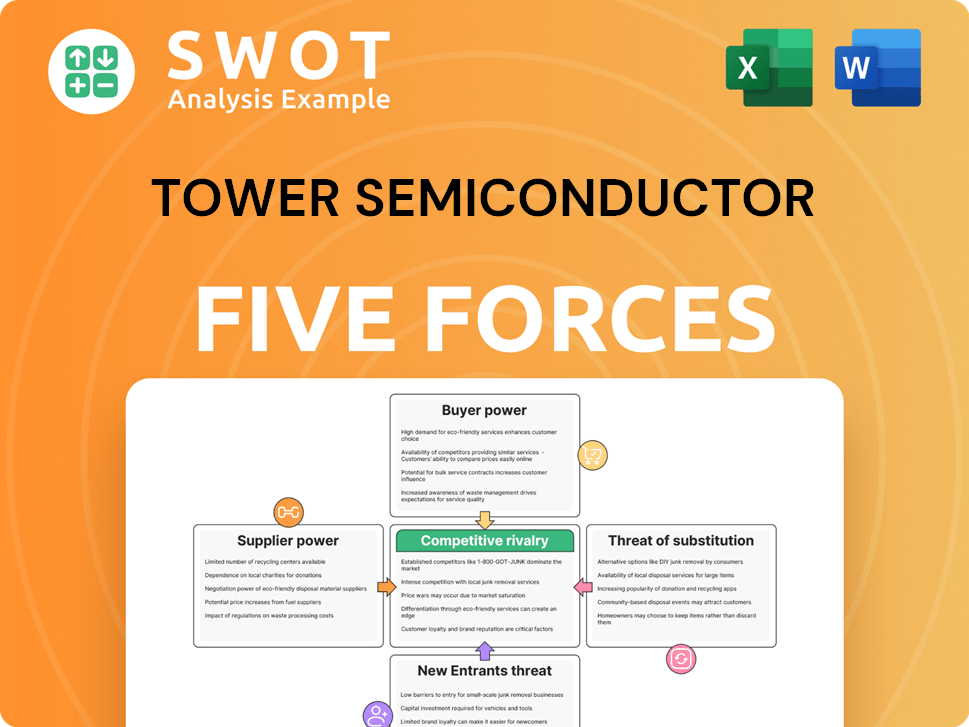
Related Blogs
- What are Mission Vision & Core Values of Tower Semiconductor Company?
- What is Competitive Landscape of Tower Semiconductor Company?
- What is Growth Strategy and Future Prospects of Tower Semiconductor Company?
- What is Sales and Marketing Strategy of Tower Semiconductor Company?
- What is Brief History of Tower Semiconductor Company?
- Who Owns Tower Semiconductor Company?
- What is Customer Demographics and Target Market of Tower Semiconductor Company?
Disclaimer
All information, articles, and product details provided on this website are for general informational and educational purposes only. We do not claim any ownership over, nor do we intend to infringe upon, any trademarks, copyrights, logos, brand names, or other intellectual property mentioned or depicted on this site. Such intellectual property remains the property of its respective owners, and any references here are made solely for identification or informational purposes, without implying any affiliation, endorsement, or partnership.
We make no representations or warranties, express or implied, regarding the accuracy, completeness, or suitability of any content or products presented. Nothing on this website should be construed as legal, tax, investment, financial, medical, or other professional advice. In addition, no part of this site—including articles or product references—constitutes a solicitation, recommendation, endorsement, advertisement, or offer to buy or sell any securities, franchises, or other financial instruments, particularly in jurisdictions where such activity would be unlawful.
All content is of a general nature and may not address the specific circumstances of any individual or entity. It is not a substitute for professional advice or services. Any actions you take based on the information provided here are strictly at your own risk. You accept full responsibility for any decisions or outcomes arising from your use of this website and agree to release us from any liability in connection with your use of, or reliance upon, the content or products found herein.